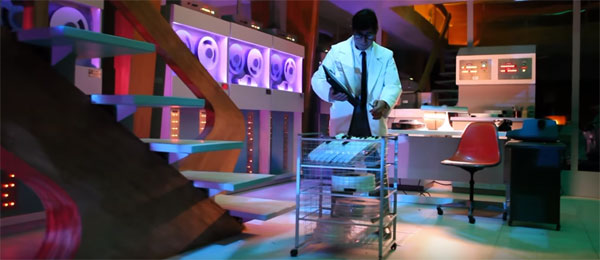
We’re nearing the top of Spaceship Earth, but there are more technological advances to explore first. These scenes following the Age of Invention have changed significantly during the last two versions. The main reason is the rise of the computer, which has been shown differently in those incarnations. This is definitely true with the current 2007 attraction, which added entirely new scenes of machines to this section. The result is a different kind of final ascent that still feels natural within Spaceship Earth.
It’s strange to admit that I didn’t remember much from the early versions of this section before I watched the online videos. One reason is that scenes of people sitting in front of computers aren’t that memorable. The other factor is that the latest section with its giant computers is really cool. It livens up a part of the attraction that once lacked the energy of earlier scenes. The scale and vibrancy of today’s presentation transforms it into a highlight.
Spaceship Earth is a long attraction with its 15-minute running time. Even so, I always feel sad at this point because we’re getting too close to the end. That vibe is even stronger today because the descent lacks show scenes. The computer section includes the last Audio-Animatronics we see now due to the anticlimactic finale. That also contributes to what makes this area memorable. We have yet to reach the top, but the segments that stick with us from Spaceship Earth are nearing their end.
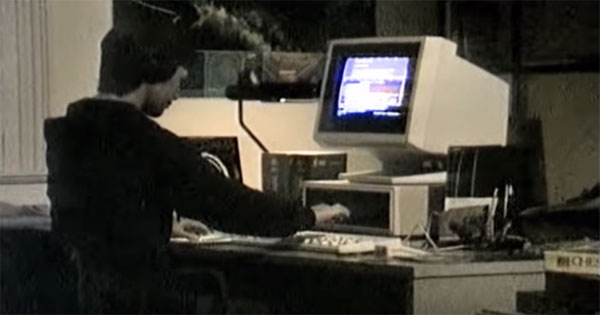
Boundless Information
A consistent trend within this scene in each version of Spaceship Earth is our increased ability to connect with each other. There is also wonder about the technological advances that bring access to information a massive scale. Even the serious approach of Vic Perrin’s narration breaks out a bit when describing the computer. Here’s the original version:
“With each day come more paths, more ideas, more dreams, and we build new machines: computer machines that think, that store, sift, sort, and count, and help us chart our course through an age of boundless information.”
The idea of charting a new course still resonates today; we’re still figuring out the best way to deal with so much access. The new tool in the ‘80s was the desktop computer, and scenes in the first two versions of Spaceship Earth drift past regular people using those early machines. I grew up during that time and remember these machines well from home and school. Walter Cronkite more succinctly describes the “ever-increasing flow of facts and figures” that the computer now tackles. We are still marveling at the invention and the potential of these powerful machines.
A memorable part of the Perrin and Cronkite attractions was the Network Operations Center. The three large maps display the communications system in Florida, the United States, and even the North Pole. It effectively presents our growing access to others and connects to both Bell System and AT&T as the sponsors. Perrin labels this scene as a “vibrant maze of billions of electronic pathways stretching to the very edge of space”. It’s an evocative way to showcase modern communications (at the time) and potential for our Spaceship Earth to get a little smaller.
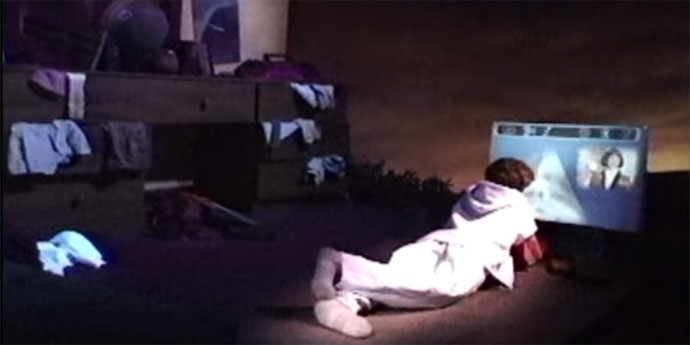
Instant Connections
Big changes appear in 1994, which makes sense given the rise of the Internet. The basic sets of the past are replaced by a boy’s messy bedroom in the U.S. as he talks to a girl in Japan. They’re both communicating in native languages, and it’s translated for the other one. A fiber-optic path ensures we recognize how technology is bringing them together. Its destination is the girl’s room in Japan on the other side of the globe. The friends exchange videos of their sports games, and it’s a fun way to convey the global network. Irons explains the changes happening in the ‘90s:
“A new communications super network is being built before our eyes. Spaceship Earth glows with billions of interactions carrying news and information at the very speed of light.”
These two scenes remind me of Horizons and the conversation between the scientist and beach boy. The enhancement here is the language translation, which shows the way two cultures can bridge the gap. It’s an optimistic look at the possibilities of the Internet. Seeing an everyday conversation also ensures we can connect with the attraction’s message. Who wouldn’t want to talk with a friend living in another country? We definitely experience that ease of communication today.
The fiber-optic lights then lead us into a sphere that signifies Earth. It’s a different approach to the transition scene that ensures we grasp the connectivity. Having the new score for 1994 drives the momentum as we build towards the attraction’s climax. Irons’ next line is among the most prescient in any version of Spaceship Earth, but I will save that for next time. We’ll stay outside the tunnel now and enjoy the energetic look at the worldwide network.
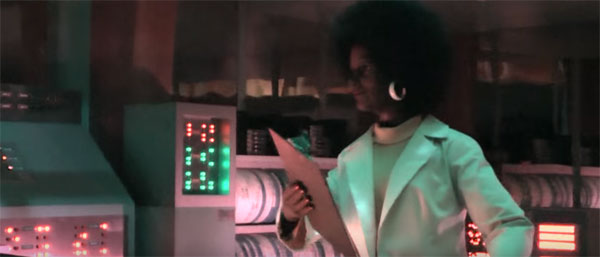
The Brink of a New Renaissance
Switching back to 2007, I love the energy of the computer scene. Following the gravity of the Apollo 11 audio, we quickly switch to a lively ‘60s vibe. I enjoy the zany feeling of the machines in this bright space. Art Director Neil Engel explained to me that the original plans for this set was supposed to be two full stories high. He used forced perspective by making the second floor a lot smaller. This design also helped to make the room seem a lot larger than its 16 feet. Both figures were reused from other scenes; the woman in the go-go boots originally was part of the radio scene. The old man near the steps was originally a scholar before that scene changed.
Our next stop is the garage in California, with a young designer “shaping the future”. While he resembles Steve Wozniak, there are mixed reports about the intended character. Engel noted that this figure is just a dummy with a wig, not a moving animatronic. The effective set design from Pete Carsillo sells the time period. I love the messy bulletin board, wires everywhere, and the clutter that fills this space. The car is an actual Chevy Vega that was installed inside Spaceship Earth. Engel related an incredible story about 20 guys lifting the car over the ride track and into the right spot. I’m nervous just thinking about the challenge of moving such a large vehicles.
As we enter the tunnel, Bruce Broughton’s score creates an inspiring feeling that anything is possible. Next time, we’ll enter the planetarium and venture into space for a grand view of our planet. We’ve reached the climax of our journey, but there’s still more to see and experience before our return to Earth. Join me once again next time as we reach the pinnacle of a 30,000-year journey through our Spaceship Earth!
Sources: INTERCOT, Martin’s Videos
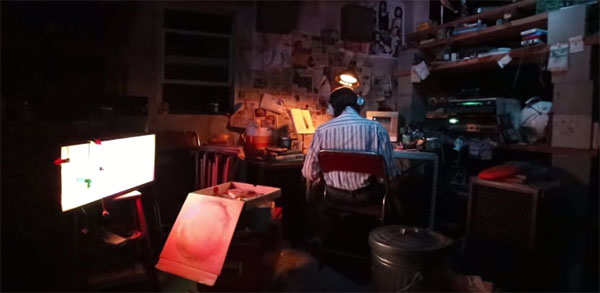



This was very informative and really took me back. I love this series and am glad that you are giving Spaceship Earth the close, detailed treatment it deserves!
Thanks again, Melanie! I feel like I’ve barely scratched the surface of what’s there inside Spaceship Earth, too. The more I learn, the more I’m impressed by all four versions.
While traveling through Spaceship Earth in the 80s I always missed the woman on the right behind the rest reading computer printouts with a mainframe computer behind her. Do you have any pictures of this scene?
I don’t have any direct photos, but I suspect you may be able to get a look with the ride-through clips from Martin’s Videos. I’d start with this one and see if it works: https://www.youtube.com/watch?v=OWPZhjyd4QM.
Thank u so much for that
No problem. I hope it helps!
Thank you for your write up on Spaceship Earth.
It’s my favorite ride and I’m happy the current version will still be around for a little while longer.
Thanks Zach! I’m also happy that the current version will get a little more life and hope to ride it again sometime next year. The way things are going, I could see it being around for a decent amount of time too.
Hello! Is there any way I could find out more information on the installation of the Vega into the ride? About 20 years ago my dad sold my mom’s eye first car- an orange Vega- which no longer worked, to someone online. The man came and picked it up from us in PA on a trailer, telling us it was going to Disney World. We always kind of wondered if that were true or what happened to it, and sort of settled that maybe it ended up in a cafe in pieces or something, and didn’t thing much about it anymore. Well…imagine our surprise when we took a big family vacation in June 2024 and just happened to ride Spaceship Earth and our jaws collectively hit the floor when we saw an orange Vega in the ride! Based on the timing I read in your article, it seems likely it could be my mom’s Vega. I’d love to find out more if you can point me in the right direction!
Hi Carley! That’s such a crazy story to locate the orange Vega inside Spaceship Earth. I”m sorry to say that I don’t have much in terms of background. My only suggestion would be to try and contact Neil Engel, who was the Art Director for the 2008 update. I know he’s on Facebook, which is where we connected when he provided info for these articles. He might have background about the orange Vega and its placement in the ride. I hope this helps!
Thank you so much for the reply! I’m going to try that!
No problem; I hope it works out!
Hey Carley Harfmann, did you find out if the orange Vega was your Mom’s car?